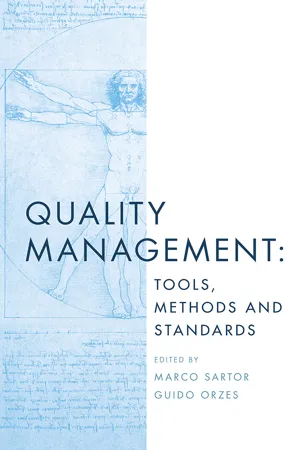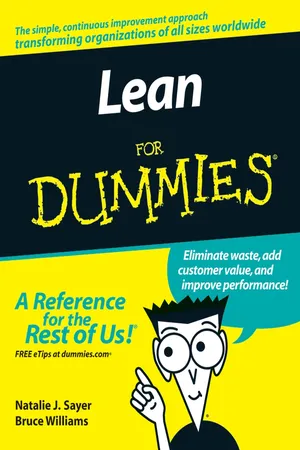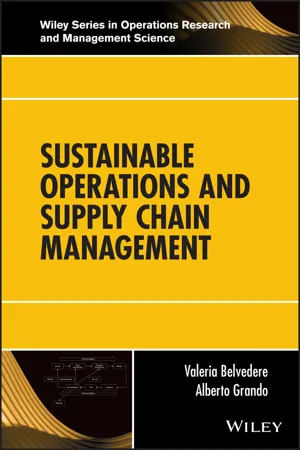Business
Lean Production
Lean production is a manufacturing philosophy focused on minimizing waste and maximizing efficiency. It emphasizes continuous improvement, just-in-time production, and a pull-based system to meet customer demand. Lean production aims to streamline processes, reduce inventory, and enhance quality, ultimately leading to cost savings and improved productivity.
Written by Perlego with AI-assistance
Related key terms
7 Key excerpts on "Lean Production"
- eBook - ePub
Quality Management
Tools, Methods and Standards
- Marco Sartor, Guido Orzes(Authors)
- 2019(Publication Date)
- Emerald Publishing Limited(Publisher)
2 have achieved remarkable results.Undoubtedly, lean management requires time, patience, long-term plans, consistent commitment, and efforts at all levels and a substantial change in mentality. It certainly requires relentless attention to the process and to the small progressive improvement made day by day. It is certainly easier to apply it in countries where individualism is less rooted. However, in a global economy it undoubtedly represents a necessary option for businesses aspiring to success.9.1. Lean Management: Some Introductory Concepts
Several authors have attempted to define lean management .Monczka, Trent, and Handfield (2005 ) argue that when company stocks have such a high turnover rate that inventories become negligible, it means that companies have adopted a system known as lean supply chain , a combination of purchases, transportation, and manufacturing focused on just-in-time (JIT).Shook (in Liker, 1998 ) defines as lean the operational philosophy that reduces the time between a customer’s order and the delivery of the requested goods through the elimination of waste.Womack and Jones – in their book Lean Thinking (2003) – claim that all activities defined as lean pursue three objectives: speeding up flows, pull planning systems, and a tireless pursuit of excellence.Lean management is often presented as a production practice, which tends to eliminate all types of waste and optimize the quality of the products at the same time. It is a way of thinking3 , an operating philosophy that combines technical and sociological aspects or, in other terms, the soft and hard sides of the enterprise (Liker & Meier, 2005 ). As Liker states in a study on the Japanese automotive industry4 - eBook - ePub
Lean Production for Competitive Advantage
A Comprehensive Guide to Lean Methodologies and Management Practices, Second Edition
- John Nicholas(Author)
- 2018(Publication Date)
- Productivity Press(Publisher)
Standardization : Variability and waste are reduced in repetitive situations when everyone and everything in the situation conforms to the same procedures and standards. A final step of every improvement effort is to establish a routine—the standard work—for everyone to subsequently follow. This provides the means by which improvements are enforced and sustained, and the jump-off point for further improvement.Lean Production is a management philosophy that goes beyond production practices to include: the roles and responsibilities of managers, support staff, frontline workers, and suppliers; their relationships with one another and with customers; and the broader issues about conducting a business. The principles of Lean Production apply to all organizations—large and small, services and manufacturing. Problems with implementing Lean Production stem largely from lack of commitment, resistance to change, and misunderstanding about what Lean Production really means. Despite differences from traditional manufacturing practices, there can be little argument that the principles behind lean make good business sense.Questions1. What is the distinction between value-added and nonvalue-added activities in a process? Give examples of each (other than from this chapter).2. Distinguish between necessary and unnecessary nonvalue-added activities. Explain how you differentiate them. Give examples (other than from this chapter). Can a nonvalue-added activity be considered necessary in some places, and unnecessary in other places? Explain.3. - eBook - ePub
- Natalie J. Sayer, Bruce Williams(Authors)
- 2011(Publication Date)
- For Dummies(Publisher)
Kaizen is performed as part of regular business practice. (Chapter 6 addresses Kaizen in detail.)In order to design, develop, or deliver any product or service, there is an associated supporting flow of information. This information is captured in the Value-Stream Map. When you buy something, for example, inventory is decreased. In order to replenish the inventory, information must flow from the retail outlet to all the suppliers. Some retailers, like Wal-Mart and Ahold, have implemented Business Process Management (BPM) systems so that from the minute you check out, the information is sent upstream and triggers reorders.Maintaining flow
When you turn on your tap, you expect to have a clean, consistent flow of water. As the customer, you’re assuming that the water is disease-free, safe to drink, and fully available when you want it, at a reasonable price. If a pump breaks or a controller fails somewhere in the delivery system, that’s someone else’s problem. You, the customer, expect flowing water on demand. The water supplier must maintain its equipment, verify the water quality, and ensure that the delivery system is safe and reliable. The supplier has little or no room for mistakes. This is an example of a system of flow.In the Lean world, this concept of flow is applied to everything, including, and especially, discrete products and services. Ideally, from the time the first action is taken in the value stream, products and services never stop until they reach the customer. From the moment the customer asks for it, products and services make their journey through a set of only value-added activities until they reach their destination. - eBook - ePub
- Natalie J. Sayer, Bruce Williams(Authors)
- 2012(Publication Date)
- For Dummies(Publisher)
Traditional sales and marketing practices need to be in step with the steady-state flow of the Lean enterprise. Sales incentives and seasonal campaigns, like inventory clearance sales or Independence Day sales, drive up demand and cause products to be sold at lower prices. This artificially bullwhips the supply chain. The concepts of level selling and steady-state pricing support a more effective enterprise.Striving for perfectionYour ability to effectively provide value to your customer relates directly to your ability to eliminate waste and keep it away, permanently. This means that Lean is a never-ending journey. Although it may sound onerous, especially in a goal-driven society, the reality is that there is and always will be something to improve. As you scrutinize your processes, you’ll discover wastes that you didn’t know existed, because they were masked by bigger wastes. It’s like draining ponds or swamps: You never really know what’s lurking beneath the surface until you’re brave enough to look — and then you have to do something about it. Lean divides the broad category of waste into seven categories and three classifications (we cover these in the “Waste not, want not” section, later in this chapter).Constant incremental improvements are achieved through kaizen. (We cover kaizen in depth in Chapter 9.) In its simplest form, kaizen means that you improve something every day. It is both a philosophy and a methodology. Kaizen improvements are generally not intended to be radical, earth-shattering improvements — instead, they’re regular incremental improvements that eliminate waste, here, there, and everywhere, bit by bit.Companies just beginning a Lean journey often use what’s known as kaizen events. Kaizen events most often begin with workshops that offer a significant opportunity for the organization. This opportunity could be a visual impact through the use of what’s known as 5S (see Chapter 11), or it could be a customer-related opportunity like significantly reducing a specific quality defect. You can also use a kaizen - Valeria Belvedere, Alberto Grando(Authors)
- 2017(Publication Date)
- Wiley(Publisher)
Flow: once the non-value-adding activities are eliminated, it is necessary to ensure that the manufacturing and logistics system functions without any interruptions that may be caused due to various circumstances. For example, unexpected downtimes due to machine breakdowns or the sudden unavailability of materials due to delays from suppliers cause inefficiencies and waste, especially waiting and the excessive accumulation of stocks of work-in-progress. From the perspective of Lean Management, it is necessary to identify and implement practices and solutions that enable processes to run smoothly and in tight sequence.- Pull: once the processes have been redesigned using the above criteria, it is necessary to ensure that each phase of the process is carried out using pull logics, that is, only if a specific request/order has been made by the customer. In the case of final product the customer is by definition external; for other manufacturing stages, the customer is represented by the department that is immediately downstream. This principle implies that nothing may be manufactured (neither finished nor semi-finished products) in the absence of demand, as in a just-in-time system.
- Perfection: Lean Management states the need to strive for continuous improvement, also called kaizen in Japanese, through the systematic analysis of value flows and the elimination of inefficiencies that may arise in the performance of manufacturing and logistic activities.
The logics and the tools that make it possible to implement these principles in practice are illustrated in the following sections.5.3.2.1 Value Stream Mapping and Pull Processes
Value Stream Mapping is the process-mapping method used to describe the current (‘as-is’) and future (‘to-be’) state of a process (Rother and Shook, 1999). More specifically, the former is the description of the way in which the process is currently managed, enriched with information suitable for identifying improvement actions. The latter is the description of how the process will look after the implementation of these actions. Value streams are generally drawn up using standard symbols, some of which are shown in Figure 5.1- eBook - ePub
Lean Implementation
Applications and Hidden Costs
- Frances Alston(Author)
- 2017(Publication Date)
- CRC Press(Publisher)
Overproduction is defined as making products in larger quantities than needed or before they will be used, leading to excessive inventory and the need for a dedicated storage space. One key aspect of producing only what is needed and avoiding overproduction is to use a pull system. In a pull system, products are produced based on fulfilling orders or requests made by the customer producing only what is requested. A pull system is used to maintain small quantities of items needed and replace only what is used. This practice helps avoid overproduction and the need to store large quantities of items for extended periods of time. Reducing overproduction reduces the amount of funds tied up in raw materials, storage space needs, and movement of inventory.1.8 Seek Perfection to Achieve Continuous ImprovementContinuous improvement in this context refers to ongoing efforts to identify and eliminate problems and to seek and implement practices or procedures to improve quality and efficiency of operation. Continuous improvement is a philosophy that seeks to improve all factors related to transforming a process on an ongoing basis. In order to achieve a culture of continuous improvement, it requires long-term support and investment by top management. Long-term support can include providing training to workers, allocating adequate resources, or continuing to foster a culture of change and employee engagement.Continuous improvement requires that the entire organization be involved in the process. Employees must be motivated and involved and accept continuous improvement as a way that the company can gain a competitive advantage and become a leader in the business segment in which they compete. Employee engagement and empowerment are key elements in the process of continuous improvement. When workers are active in reporting issues to management and helping management seek solutions to problems, continuous improvement becomes a constant part of the business practices.1.9 Overview of Lean ToolsIn this section, several Lean tools will be highlighted that can be of some use during the transition process. These tools can also be useful in fostering a workplace culture that is needed to sustain process improvement for the long haul. Not all of the tools mentioned will be useful for every change in operation, practice, or procedure. The tools discussed are not represented as an all-inclusive list, recognizing that there are other tools that may achieve the same level of success in implementation. - eBook - ePub
- Larry Webber, Michael Wallace(Authors)
- 2011(Publication Date)
- For Dummies(Publisher)
Other principles support the elimination of waste and the goal of exceeding customer expectations. These principles include careful planning of production schedules, prompt attention to quality problems, and worker involvement (they often have the best ideas).Taking important steps for getting Lean and mean
The steps in the following sections support your organization’s Lean journey. Your organization needs to address all the steps, but the sequence in which you move and the emphasis you place on the different steps depends on your specific situation.An organization can view processes at the micro level, such as the process of answering a phone, or from a broader perspective, such as the process of taking a customer order. Lean tools, when implemented in an established company, are best applied at the micro level. A company can attempt to tackle higher-level processes after it Leans some of the component processes. As the company Leans its processes, it may evolve into a Lean enterprise. The company shouldn’t view the transformation as a one-time initiative; instead, it should adopt a long-term, enterprise-wide view of all processes. Lean operating principles become the overall culture of the organization, with the elimination of waste as the target for improvement based on exceeding customer expectations.Agree on areas to target
Before you target certain processes for Lean, you should start by addressing the core value stream of the organization. The important thing for Lean is that the top executives agree on the areas to target and involve themselves in the process of the change. This agreement and involvement does two things:All workers involved in the Lean movement should view the changes from the perspective of changing the culture of the organization and demonstrating a “bias for action.”It demonstrates the commitment of the leaders.It allows the leaders to identify waste in the organization’s core processes.Here’s some advice for company leaders: Take the time to do your homework before you jump in. There’s plenty more to becoming Lean than just implementing a single tool or changing a single process. People have written books on the process of implementing Lean, and legions of consultants, integrators, and other professionals are ready to help (see Chapter 5 for details on finding these folks). Talk with other companies that are sound examples of Lean enterprises or are solidly on their way; most of these organizations will be willing to share their experiences. Benchmarking is an excellent way to find out about the processes that support Lean organizations.
Learn about this page
Index pages curate the most relevant extracts from our library of academic textbooks. They’ve been created using an in-house natural language model (NLM), each adding context and meaning to key research topics.






